Works
The music manuscript in Florence, Biblioteca Nazionale Centrale, Ms. Magl. xix.176, is important as a source for Mureau’s chansons. It is the only source to give his name by more than one composition as it contains three songs ascribed to him, and it is an early source for his music. The recently discovered Leuven chansonnier, which contains his ‘hit’ song “Je ne fais plus”, is probably sligtly older. Florence 176 is a small format paper manuscript (168 x 118 mm) of 139 folios.(1) Nearly all of its repertory was collected and copied by a single Italian scribe in Florence around or before 1480. This scribe had access to French exemplars that must have been practically contemporary with the repertory of the so-called ‘Loire Valley’ chansonniers. Of the 84 French, Italian and Spanish songs he entered in Florence 176, 27 are concordances to songs in the Loire Valley chansonniers – of these only two were added to the group of chansonniers by later hands; in no less than five instances, Florence 176 is the only concordance outside the group of French chansonniers that we know of (Florence 176 nos. 8, 25, 26, 32 and 78). In most cases the main scribe copied his exemplars accurately when we look at the music, but apparently he did not understand French at all. As a result, his texts are either missing, fragmentary or consisting in incipits only, and often quite corrupt. Two later hands have added compositions on the manuscript’s final folios, and a fourth user has added the index, foliation, attributions and other completions.(2) This last user had an intimate knowledge of French music, and especially of music in Central France. Among the French pieces, he identified five pieces as being by “duffay”, three by “muream”, three by “Raulin” (Johannes Raoullin, who in 1464 was a singer in the chapel of Charles d’Orléans (3)), two by “mortom” (Robert Morton), two by “Bellingan” (Johannes Bedyngham), one each by “Busnois”, “Ockeghem”, “Carom” (Caron), “fede” (Jean Sohier, active in the Loire Valley c1450-c1475), “Jo tinctoris” and “Michelet” (?). Even if the scribe was in error in ascribing “L’omme banny de sa plaisance” to Fedé,(4) it detracts nothing from the credibility of his other names of composers. In addition to older and internationally renowned names as Du Fay, Morton and Bedyngham, the ascriptions show a remarkable concentration on composers active in the royal lands of Central France with Ockeghem and Busnoys, and with the names hardly ever mentioned in musical sources such as Mureau, Raoullin, Tinctoris and Fedé – as if the scribe’s view of contemporary France was shaped by a recent stay in Orléans, Blois or Tours.
Only one further source adds a song to the list of works. It is the big chansonnier in Florence, Biblioteca Nazionale Centrale, Ms. Banco Rari 229, which was made in Florence during the first years of the 1490s.(5) It contains a three-part rondeau with the garbled text incipit, “Penses ycelle”, and the composer’s name is given as “Murian”. This means that the three songs in Florence 176 and the one in Florence 229 are preserved without complete and reliable texts in their oldest sources. However, it is in all cases possible to recover the texts with the help of French musical or poetical sources. This is a lucky situation, because the poems hold the key to much of the art and the distinguishing traits of Mureau. Let us start with »Grace actendant ou la mort pour tous mes«, in which the text as well as the ascription in Florence 176 gives evidence to Mureau’s authorship, and this song is his most original creation.
The initial letters of the lines in the poem, a bergerette with a four-line refrain, form the acrostic GILLES MUREAU; the rime syllables are in the first section (refrain and tierce) “-mes/mais” and “-usé” in the pattern ABBA, while the contrasting second section (couplets) uses “-oureux” and “-ame”, CDCD.(6) These rimes combined with the acrostic place the poem securely in the literary sphere, in l’Art de Rhétorique of the 15th century. While most of the poems used for music depend on perfectly satisfactory rimes (rimes suffisantes), a rhétoriqueur prefers rimes riches, which can be graded from rimes léonines to a still higher complexity in diverse forms of rimes équivoques.(7) Mureau’s rimes in this poem belong to the léonines by showing identity in three elements each. This fashionable love complaint has everything one might expect from a maître de grammaire in charge of the children of the nobility – a visiting card of a poet-musician.
The two other poems in the same vein, “Tant fort me tarde” and “Je ne fais plus”, for his songs in Florence 176 take the art of the rhétoriqueur a step further as they both use rimes équivoques, that is when the same words or syllables are used as rime words, looking or sounding alike, but with different meanings. In »Tant fort me tarde ta venue« Mureau displays another favoured device of the réthoriquears, that of posing as the opposite gender; here he writes in a female voice in an intimate tone. Characteristic also are the rimes of »Je ne fais plus, je ne dis ne escrips«: “escris / escris / descris / et cris / acris / escris / precris / qu’Antecrix” and “plains / plains …” – a quite virtuosic performance. In addition, this song is cast in the rather uncommon form of a rondeau tercet layé with only five lines in its refrain – usually short lines are interpolated into the four or five lines of the refrain, but here we find only three long lines, handled by a very sure poetic hand. Seen in connection with Grace actendant, one cannot doubt that the manuscript’s attribution of these songs to Mureau applies to the poems as well as to the music. Only the rondeau »Pensez y se le povez faire« found in Florence 229 does not in its common but completely adequate rimes match the literary ambitions demonstrated by the other poems. However, an analysis of its musical traits shows that its ascription to Mureau is quite credible.
The music of the four chansons complies with the general characteristics of French songs in the early 1460s setting poems in formes fixes. They build on a structural duet of superius and tenor supported by a contratenor in either the same range as the tenor or in a slightly lower range; they set the poems line for line while observing a suitable alternation of declamatory passages and melismatic endings. Imitation between the voices does not play any important role for Mureau, but it occurs as an element of variation in the musical discourse – more on this and the topics of the following discussion, see the comments on the single editions.
To discuss personal traits in the forme fixe chansons of the 1460s and early 1470s is difficult; it must be in the form of descriptions of tendencies, which relate to a norm that can be quite elusive. On the other hand, it is remarkable that three songs (Grace actendant, Je ne fais plus, Pensez y) use a very high tessitura as if they were expressly destined for boys’ voices. This seems relevant considering Mureau’s occupation as a teacher and performer with the boys at the Chartres maîtrise. Still more characteristic is a tendency to declaim the words clearly in tranquil note values for longer stretches and preferably in more than one voice at the same time; again, interesting in view of his position as maïtre de grammaire. His concern for the intelligibility of the words in performance appears modern, forward-looking on the background of contemporary tendencies. However, this may to some degree be contradicted by such old-fashioned traits as his use of a high contratenor crossing above the tenor at cadences, and the tendency to parallelism between voices, or downright faulxbourdon-like passages, which can be found in Tant fort me tarde and Grace actendant.
Mureau shows an ability to make the upper voice seemingly ‘float’ upon the web of the lower voices. Je ne fais plus is a particularly successful example of this, and it may be one of the reasons for the song’s lasting popularity. This furthermore calls attention to a musical trait, to which he apparently resorted quite often, namely to exploit the driving force of the traditional cadence configuration with suspension and resolution in order to set off or animate a melodic development long before the arrival of the phrase’s ending. The memorable opening of Je ne fais plus can stand as a sort of paradigm of this technique, and later on it is used to energize the song’s culmination (ex. 1). In Grace actendant we find a similar push forward in bars 32-33 and 35-36, and very characteristic at the run-up to the three-part faulxbourdon cadence in bars 48-50 (ex. 2); in »Tant fort me tarde ta venue« it is used to propel the beginning of the long final phrase in bars 42-47 (ex. 3).
Ex. 1, Mureau, Je ne fais plus, bars 33-37
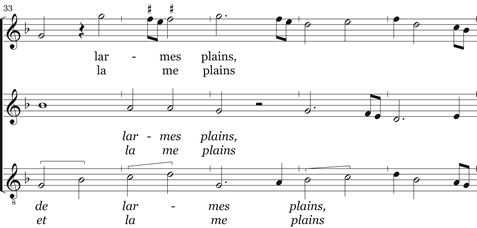
Ex. 2, Mureau, Grace actendant, bars 48-51
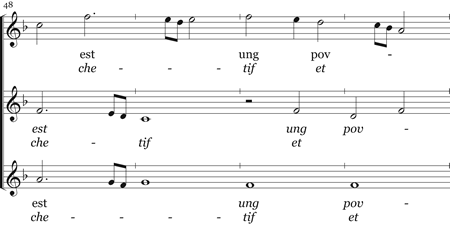
Ex. 3, Mureau, Tant fort me tarde, bars 42-47
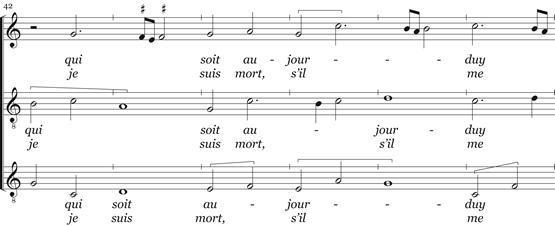
That the text was important to the composer also when he was designing the lower voices, is made obvious by some details in Je ne fais plus and Pensez y se le povez faire. In the former the syllabic setting in the tenor and the use of tone repetitions virtually force a repeat of the last words of the text line just before the medial cadence (bb. 27-28, ex. 4); and something quite similar happens in the contratenor of Pensez y (bb. 22-24, ex. 5). In this connection it is interesting that tone repetitions provoke a analogous placement of the last three syllables before the medial cadence in the contratenor of Tant fort me tarde (bb. 30-31, ex. 6); in this case, however, no text repetition is needed.
Ex. 4, Mureau, Je ne fais plus, bars 27-29
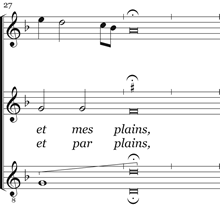
Ex. 5, Mureau, Pensez y se le povez faire, bars 22-24
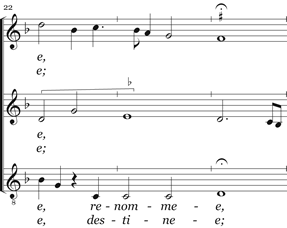
Ex. 6, Mureau, Tant fort me tarde, bars 29-31
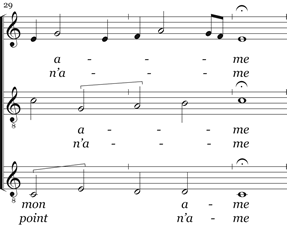
Poems intended for musical setting were traditionally made in such a way that it seemed natural in the rondeau to repeat the first half of the refrain after the short couplet and the complete refrain after the tierce, and likewise the complete first section at the end of the bergerette. When these forms became popular as poetry for reading or reciting without music during the 15th century (Christine de Pisan, Charles d’Orléans and others), repeats were often reduced to a single line or the first words (rentrement) only, which had to be integrated inro the discourse of the preceding formal section; accordingly, Charles d’Orléans distinguished between rondeaux and chansons (rondeaux made for music). The literary ambitions of Mureau are clearly in evidence – he did work and experiment with the form. In »Tant fort me tarde ta venue« the sense of the refrain does not permit a repeat of the first three lines as a unit, while the first line alone constitutes a satisfactory ‘short refrain’ after the couplet; nothing hinders a complete repeat of the refrain at the end of the song. Conversely, in »Grace actendant ou la mort pour tous mes« it is the music that resists a repeat of the complete first section at the bergerette’s end, because this would result in a quite implausible ending on the mode’s fifth degree and with a third in the final chord. The solution is again the ‘short refrain’ of the first line only, which brings a natural completion to the music as well as to the sense of the poem.(8)
Two of the three chansons by Mureau in Florence 176 may have left the composer’s hand notated in fa-clefs. The highest parts of Grace actendant and Je ne fais plus are notated in G2-clefs and key signatures of three flats at the positions f’, b’ and f’’. Moreover, also thelower voices of Je ne fais plus are notated with three flats (he flats in the contratenor of Je ne fais plus were most probably copied after a faulty exemplar, see further the comments on the song). The notational peculiarity of seemingly superfluous signs is possible evidence that they originally were notated without letter-clefs, in formations of fa-clefs alone, three or two flats to each voice are typical. This means that the songs were notated not at a fixed pitch, but could be performed at any convenient pitch. The fa-clef notation seems to have been used by composers around Binchois and in Central France in the 1450s and the early 1460s (Ockeghem, Barbingant, Le Rouge). Knowledge of the notation soon faded away, and the songs were then in later sources transmitted in fixed-pitch notation (Cf. my article ‘On chansons notated in fa-clefs – and the question of pitch in 15th century secular music’). This is interesting because Florence 176 contains the most authoritative version of Barbingant’s “L’omme banny de sa plaisance”,notated entirely in fa-clefs (ff. 54v-55; ascribed to Fedé). This suggests that Mureau in these high-range songs made use of a notational praxis, which was relatively well known in his region, in order to render the songs performable for others than groups with boys. Of course, another possibility could be that he imitated the notation of songs by older composers, which at that time circulated in fixed notation including ‘ssuperfluous’ flats, in order to gain some additional status.
The music of Grace actendant is for sure Mureau’s most ambitious effort, probably it was a bit too unusual to secure it a popularity comparable to that of Je ne fais plus. It is composed for four voices in an original working out of the principle of contrast characteristic of the bergerette, namely by the use of vocal instrumentation. Two worlds of sound are juxtaposed, both quite new in the secular music of the 1460s: a four-part voice disposition (a group of boys on the upper parts and two men) contrasting with three equal high parts (three boys solo?). To this we can add the artful poem, the ingenious use of ‘short refrain’ at the end of the song, and the possible original notation without letter-clefs.
Along with Mureau’s other masterpiece, Je ne fais plus, which is just as original in its own way, it probably originated during the years around 1470, a bit late for inclusion in the majority of the ‘Loire Valley’ chansonniers, that is, during the years when his reputation as a teacher of grammar and music in the maîtrise of Chartres and as a teacher of private pupils was growing. Pensez y se le povez faire seems slighter, but may belong to the same period. In comparison, Tant fort me tarde appears much more old-fashioned, less experimenting, for voices in a ‘normal’ tessitura, and with an extended use of parallelism between the parts. It may be a result of his early years. It did inspire the young Philippe Basiron, but only the poem was of any interest to him, and he provided a totally dissimilar setting (on the poetic relationship between Basiron and Mureau, see my article ‘The chansons of Basiron’s youth and the dating of the ‘Loire Valley’; chansonniers’.
PWCH, August 2011
1) For a description and contents of the manuscript, see Bianca Becherini, Catalogo dei Manoscritti Musicali delle Biblioteca Nazionale di Firenze. Kassel 1959, pp.72-75; idem, ‘Autori minori nel codice fiorentino Magl.XIX.176’, Revue Belge de Musicologie IV (1950), pp. 19-31; Knud Jeppesen: La Frottola I-III. Copenhagen 1968-70, vol. 2, pp. 57-58; Census-Catalogue of Manuscript Sources of Polyphonic Music 1400-1550, 5 vols., Neuhausen-Stuttgart 1979-1988, vol. 4, p. 374; RISM B IV/5 (1991), pp. 171 ff.
2) Cf. Joshua Rifkin, ‘Scribal Concordances for Some Renaissance Manuscripts in Florentine Libraries’, Journal of the American Musicological Society 1973, pp. 305-328 at p. 318, note 34.
3) Paula Higgins, ‘Speaking of the Devil and Discipuli: Eloy d’Amerval, Saint-Martin of Tours, and Music in the Loire Valley, ca. 1465-1505’ in M. Jennifer Bloxam, Gioia Filocamo, and Leofranc Holford-Strevens (eds.), Uno gentile et subtile ingenio. Studies in Renaissance Music in Honour of Bonnie J. Blackburn. CESR Tours 2009, pp. 169-182, at p. 181.
4) The ascription of the song to Barbingant by Tinctoris, who spent many years in the Loire Valley, ‘overrules’ the Florence 176 ascription. However, the original scribe of this MS was the only one with access to the probably correct version of the song’s original notation in fa-clefs, see further the discussion at http://chansonniers.pwch.dk/CH/CH099.html.
5) Cf. the complete edition and discussion of the source in Howard Mayer Brown, A Florentine Chansonnier from the Time of Lorenzo the Magnificient. Florence, Biblioteca Nazionale Centrale MS Banco Rari 229 (Monuments of Renaissance Music VII) Chicago 1983.
6) Exactly the stringent formation of the rimes permits the reconstruction of the original appearance of the poem, see the edition; the form in which the poem is preserved in Le jardin de plaisance produces a misleading acrostic: GILLES MUREUE; cf. the faulty edition of the song in E. Droz et G. Thibault, Poètes et musiciens de xve siècle. Paris 1924,pp. 43-48.
7) The main 15th-century manuals of the craft of poetry are edited in Ernest Langlois (ed.), Recueil d’arts de seconde rhétorique. Paris 1902; see for example the lists under the heading “Et premièrement une règle de moz léonines et plains sonans et esquivoques et presonans” in the anonymous treatise Les Règles de la Seconde Rhétorique from the early 15th century (Langlois, p. 15).
8) Cf. Daniel Calvez, ‘La Structure du rondeau: mise au point’, The French Review 55 (1982), pp. 461-470, and the editions. The two remaining songs, Je ne fais plus and Pensez y, can be performed with short refrains after the couplets as well, but it is not necessary.